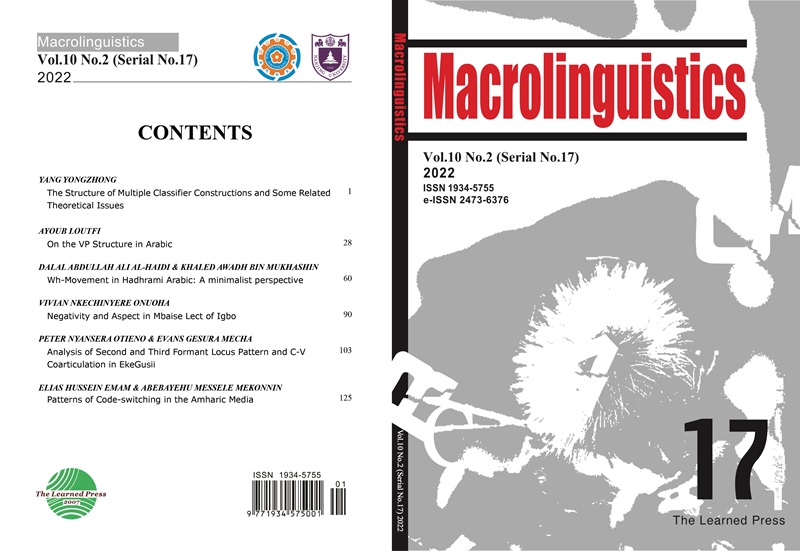Isekírì中音的最优性理论分析
引用次数: 0
摘要
Yoruboid文献和以前对Iṣ中语气行为的描述中已经报道了中间语气的不对称行为ẹkírì认为,在单词边界处,低音总是被删除,以利于其他人。然而,同步数据表明情况并非如此。本文研究了《Iṣ》中的音调不对称和中间音在某些语音过程中的不参与ẹkírì。本研究采用了最优性理论(OT)版本,该版本结合了基础条件,将隐含陈述的约束发展为忠实约束。数据来自八位该语言的使用者,录音是在数字音频设备的帮助下进行的,用于声学测量的工具是Praat 6.0.30。分析表明,这种语言中的音调不对称总是会删除词界的中调,而不是低音,同时也注意到在某些情况下低音可能会被删除。M音在元音省略、滑音形成和元音同化等语音过程中缺乏参与,这揭示了Iṣ中M音的不稳定性质ẹkírì。本文的结论是,在iṣ中,M音调与H和L音调不对称ẹkírì,并证明了对Iṣ中的音调行为进行更多感知和声学研究的必要性ẹkírì。本文章由计算机程序翻译,如有差异,请以英文原文为准。
An Optimality Theoretic Analysis of the Mid Tone in Isekírì
The asymmetric behaviour of the mid tone has been reported in the Yoruboid literature and previous accounts of tone behaviour in Iṣẹkírì suggest that a low tone is always deleted in favour of others at word boundary. However, synchronic data have shown that this is not the case. This paper investigates tonal asymmetry and the non-participation of the mid tone in some phonological processes in Iṣẹkírì. The study adopts an Optimality Theory (OT) version that incorporates the grounding conditions to develop constraints of implicational statements into faithfulness constraints. Data are elicited from eight speakers of the language, recordings are with the aid of a digital audio device and the tool used for our acoustic measurement is Praat 6.0.30. The analysis reveals that tonal asymmetry in this language always deletes the Mid-tone at word boundary and not the Low tone, also noting that the Low tone may be deleted in some cases. The lack of participation of the M tone in some phonological processes such as vowel elision, glide formation and vowel assimilation reveals the unstable nature of this tone in Iṣẹkírì. This paper concludes that the M tone is in asymmetry to the H and L tones in Iṣẹkírì and demonstrates the need for more perceptual and acoustic studies of tonal behaviour in Iṣẹkírì.
求助全文
通过发布文献求助,成功后即可免费获取论文全文。
去求助
来源期刊
自引率
0.00%
发文量
83
审稿时长
20 weeks
期刊介绍:
Macrolinguistics (ISSN 1934-5755, e-ISSN 2473-6376) is an international academic journal which is specialized in research papers of non-Indo-European linguistics. It is published biannually by The Learned Press and funded by the Double First-Class Initiative of Nanjing University. It aims at contributing to the complementarity and interaction of linguistic research worldwide.

 求助内容:
求助内容: 应助结果提醒方式:
应助结果提醒方式:


